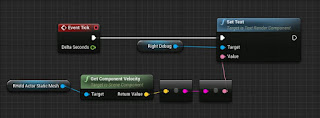This has been a little bit confusing so I thought I'd share. When working with motioncontrollers I often want to know how fast the player is moving his hands/weapons. There are two ways one might think to do this: This will constantly return 0, and I thought it was weird. Apparently, Get Component Velocity returns Velocity relative to the parent, and since Rheld Actor Static Mesh is attached to the motioncontroller component (it's parent), this will always return 0. The right way to do it is using this function instead: " Linear velocity is the velocity of the object traveling in a straight line or in other words the body is said to be moving with linear velocity when its direction is not changing." I'm confused about this because the player is almost always changing the direction of where he moves the motioncontroller, so it seems like I would want "Physics Velocity", and not linear. This function does however not exist. Using Linear Ve

